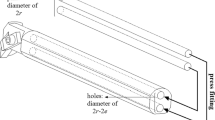Abstract
Chatter is a self-excited phenomenon in machining, especially in boring and end milling processes due to the slender nature. A passive approach of copper-based shape memory alloy frictional damping has been provided to suppress the tool chatter. Boring tools made of EN31 material have been chosen and damped with frictional dampers made of copper-based shape memory alloy such as naval brass, Muntz metal and leaded brass. Characterization study of shape memory alloys was performed using the X-ray analytical microscope, differential scanning calorimetry and impact hammer test for element confirmation, transition temperature and modal analysis, respectively. Machining performance of the proposed damping bars was investigated through logarithmic decrement, damping ratio and resonance gap of the machining system, as well as the displacement, temperature, tool wear and surface roughness in the boring process. The comparative study was reported between the damped and undamped boring bars. The comparative study revealed that better results were obtained from the boring bar damped with leaded brass. A 19.2%, 55%, 59.9% and 78.1% of reduction was witnessed in terms of temperature, displacement, surface roughness and tool wear of the boring bar damped with leaded brass compared with the unchanged boring tool holder.










Similar content being viewed by others
Change history
23 June 2021
A Correction to this paper has been published: https://doi.org/10.1007/s13369-021-05860-9
References
Patoor, E.; Lagoudas, D.C.; Entchev, P.B.; Brinson, L.C.; Gao, X.: Shape memory alloys, Part I: General properties and modeling of single crystals. Mech. Mater. 38(5–6), 391–429 (2006)
Caughey, T.K.; O’Kelly, M.E.J.: Effect of damping on the natural frequencies of linear dynamic systems. J. Acoust. Soc. Am. 33(11), 1458–1461 (1961)
Tobias, S.A.: Machine-Tool Vibration. Wiley, London (1965)
Adams, R.D.: The damping characteristics of certain steels, cast irons and other metals. J. Sound Vib. 23(2), 199–216 (1972)
Otsuka, K.; Shimuzu, K.: Pseudo-elasticity and shape memory effects in alloys. Int. Metal Rev. 31(3), 93–114 (1986)
Ema, S.; Marui, E.: A fundamental study on impact dampers. Int. J. Mach. Tools Manuf 34(3), 407–421 (1994)
Liang, C.; Rogers, C.A.: Design of shape memory alloy springs with applications in vibration control. J. Intell. Mater. Syst. Struct. 8, 314–322 (1997)
Chung, C.Y.; Lam, C.W.H.; Tan, S.S.: Effect of parent phase ageing on Cu-Zn-Al shape memory alloys with Mn and Zr addition. Mater. Letts. 33, 291–296 (1998)
Otsuka, K.; Wayman, C.M.: Shape Memory Materials. Cambridge University Press, Cambridge (1998)
Edhi, E.; Hoshi, T.: Stabilization of high frequency chatter vibration in fine boring by friction damper. Precis. Eng. 25(3), 224–234 (2001)
Van Humbeeck, J.: Damping capacity of thermo-elastic martensite in shape memory alloys. J. Alloys Compounds 355(1–2), 58–64 (2003)
Ziegert, J.C.; Stanislaus, C.; Schmitz, T.L.: Enhanced damping in long slender end mills. J. Manuf. Process. 8(1), 39–46 (2006)
Gonzalez, C.H.; Oliveira, C.A.D.N.; Pina, E.A.C.D.; Filho, S.L.U.; Araujofilho, O.O.D.: Electro-thermomechanical properties of super elasticity in single crystals shape memory alloys. Mater. Res. 13(2), 233–238 (2010)
Madoliat, R.; Hayati, S.; Ghalebahman, A.G.: Investigation of chatter suppression in slender endmill via a frictional damper. Sci. Iranica Trans. B: Mech. Eng. 18(5), 1069–1077 (2011)
Biffi, C.A.; Bassani, P.; Tuissi, A.; Carnevale, M.; Lecis, N.; Loconte, A.; Previtali, B.: Numerical and experimental characterizations of damping properties of SMAs composite for vibration control systems. J. Mater. Eng. Perform. 21, 2713–2718 (2012)
Ramesh, K.; Alwarsamy, T.; Jayabal, S.: Investigation of chatter stability in boring tool and tool wear prediction using neural network. Int. J. Mach. Mach. Mater. 46(1), 47–70 (2013)
Wang, M.; Zan, T.; Gao, X.: Modeling and optimization of a friction damper for boring chatter control. Adv. Mech. Eng. 2014, 1–8 (2014)
Asanovic, V.; Delijic, K.: The mechanical behavior and shape memory recovery of Cu-Zn-Al Alloys. Assoc. Metall. Eng. Serbia (AMES) 13(1), 59–64 (2007)
Chockalingam, S.; Natarajan, U.; George Cyril, A.: Damping investigation in boring bar using hybrid copper-zinc particles. J. Vib. Control 23(13), 2128–2134 (2017)
Chockalingam, S.; Natarajan, U.; Kalyana Sundaram, S.: Modeling and optimization of tool wear in a passively damped boring process using response surface methodology. Trans. Indian Inst. Metals 69, 1443–1448 (2016)
Chockalingam, S.; Ramabalan, S.; Govindan, K.: Chatter control and stability analysis in cantilever boring bar using FEA methods. Mater. Today Proce. (2020). https://doi.org/10.1016/j.matpr.2019.12.166
Thomas, W.; Fulop, Z.; Szilágyi, A.: Passive damping techniques for vibration suppression in boring operation with long overhangs. In: Jármai, K., Voith, K. (eds.) Vehicle and Automotive Engineering 3. VAE 2020. Lecture Notes in Mechanical Engineering, pp. 256–264. Springer, Singapore (2021). https://doi.org/10.1007/978-981-15-9529-5_22
Muthu, E.; Dashora, S.; Nandakumar, P.: Experimental investigation of particle impact damping on machine tools. IOP Conf. Series Mater. Sci. Eng. 912(2), 022047 (2020)
Baranitharan, P.: Investigation on the effects of damping over the temperature distribution on internal turning bar using Infrared fusion thermal imager analysis via SmartView software. Measurement 162, 107938 (2020)
Zhang, J.; Wang, H.; Ren, Y.; Feng, C.; Zhang, C.: Chatter and stability analysis of the slender composite boring bar with constrained damping layer. Appl. Sci. 10(13), 4537 (2020)
Author information
Authors and Affiliations
Corresponding author
Additional information
The original publication of the article was revised: The affiliation cross reference for the corresponding author has been corrected.
Rights and permissions
About this article
Cite this article
Singaravelu, C., Varatharajan, P., Ramu, G. et al. Investigation of Damping Characteristics on Copper-Based Shape Memory Alloy Frictional Damper in Boring Process. Arab J Sci Eng 46, 11859–11870 (2021). https://doi.org/10.1007/s13369-021-05719-z
Received:
Accepted:
Published:
Issue Date:
DOI: https://doi.org/10.1007/s13369-021-05719-z




